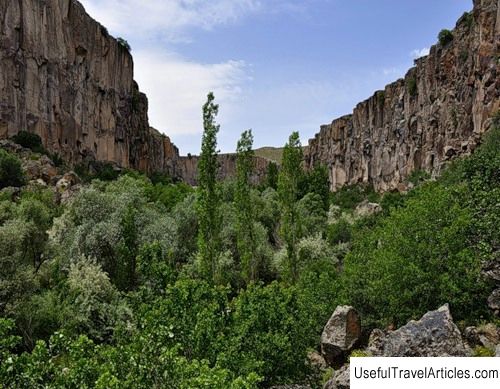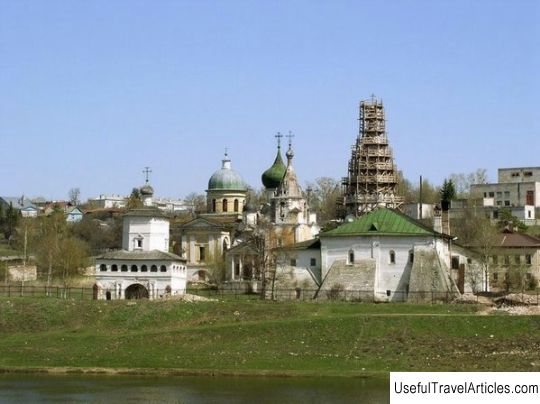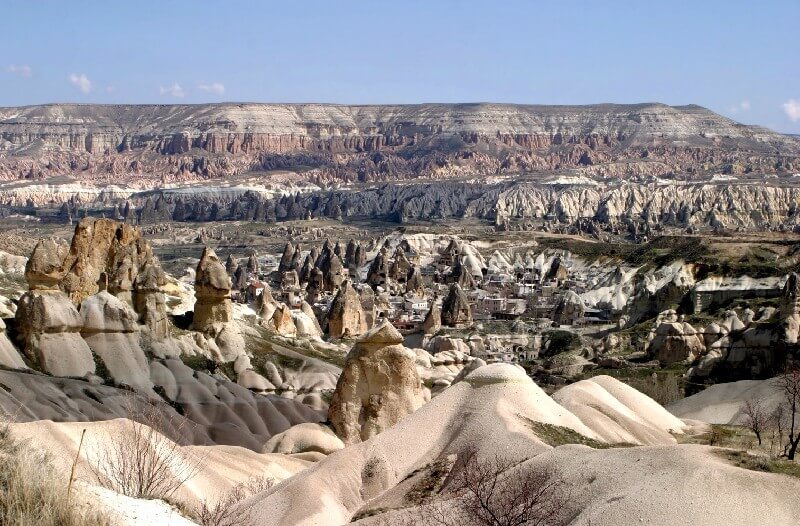Canyon Ihlara (Ihlara Vadisi) description and photos - Turkey: Cappadocia
Rating: 8,0/10 (675 votes) 
Ihlara Canyon (Ihlara Vadisi) description and photos - Turkey: Cappadocia. Detailed information about the attraction. Description, photographs and a map showing the nearest significant objects. The title in English is Ihlara Vadisi. Photo and descriptionCappadocia is located about four hundred kilometers southeast of Ankara, it is an area centered on the Erdash Dagi peak (1982 m). It starts from the Ihlara canyon. The Ihlara Valley (Ihlara, the Byzantine name is Peristrem) is a volcanic canyon in Central Anatolia with a length of 16 kilometers and a height of about 150 meters (it starts near the village of Ihlara and ends at Selime). Located at a distance of about 40 km south of the city of Aksaray in Turkey and west of the city of Nigde. In this picturesque valley there are many churches of the first centuries of Christianity, which are of great artistic interest, as well as dwelling houses in the form of caves for five thousand inhabitants, six of which are open to the public. These monuments of ancient culture look very beautiful against the backdrop of amazingly beautiful nature: a cheerful palette of wildflowers, rustling of a river and green foliage. Churches are carved into the rocks, there are about a hundred of them here. The construction of churches began in the 4th century. They were decorated with frescoes of Syrian origin, which already date back to the first years of the 9th century. At the very beginning, these frescoes were small-colored (just a couple of shades of red on a white background) and very simple in their execution. Somewhere from the beginning of the 11th century, the range becomes more saturated, since the Syrian-Egyptian style prevailing here was diluted with Byzantine influence, as well as the influence exerted by the religious mosaics of the largest churches of that period. Of all the churches in the Ihlara Valley, only 14 are open for inspection. what to see: Syumbulu Kilise ("The Church of the Hyacinths"), Agach Alti Kilise ("The Church under the Trees"), Ilanli Kilise ("The Church of Snakes"), "Egritash", "Kokar-ilisesi", "Purenli Seki", "Ala Kilisesi "," Bakhattin Sammanlygy "," Kirkdamatly "," Direkli ", etc. Often, these names were given to churches by local residents, but some were named after the owners of the land on which they were located. The walls of all churches are decorated with images of saints and various scenes from the Bible. There are also not restored images of pre-biblical & nbsp; period. Many churches form a city in the rock with each other - they are connected by underground passages. Ihlara Canyon in a reduced version is a bit like the well-known and famous Grand Canyon in America. A large crack, as if in a science fiction movie, cuts through the earth and bends as a green snake across the sandy bare plain. It seems that the mother earth itself, having opened, released the valley outward, unable to hide such beauty any longer. Ihlara contrasts very well with the usual hilly local landscape. Among the kingdom of huge gray stones, there is a green spot of an oasis, in which the crowns of age-old trees sway majestically, creating a pleasant partial shade. Nimble lizards flit between large boulders, turtles crawl slowly, and birds chirp and butterflies flutter in the lush greenery. Scientists have very different opinions about the origin of the Ihlara Valley. Some geologists claim that this giant canyon was carved by the waters of the Melendiz - a mountain river that flows down the slopes of the mountain of the same name. Other scientists hold a completely different opinion - this fantastic canyon is of volcanic origin, but information about an active volcano in this area has not been recorded in any historical document. However, there is also the most plausible third version, which peacefully unites the supporters of the first two theories. According to her, this canyon was formed by the joint efforts of the volcano and the river. It turns out that two extinct volcanoes located on both sides of the valley covered it with layers of ash, lava, and tuff. And later the river took matters into its own hands and washed away all the volcanic remains, as a result, the descendants received an amazing canyon of the Ihlarskaya valley. Among all this idyll, black dots look out of the steep cliffs with black eyes - these are the entrances to cave houses. One gets the impression that you are looking at a huge anthill up close. If you wish, you can also familiarize yourself with these cave dwellings in more detail. Not far from Ihlara, just two kilometers away, there is the most popular and convenient descent in the Ihlara Gorge. Tourists have the opportunity to visit here as part of a group on a one-day excursion organized by the travel agencies of Cappadocia. The gorge is 10 km long and 80 m deep. You can walk along it. There is a suitable route along the Melendiz river. If such a walk seems too long for you, then you can go down into the gorge using a metal staircase of 382 steps in total. However, keep in mind that this is not easy. But below, nature has prepared an unforgettable gift for you - indescribable beauty. There is a small complex nearby for the convenience of tourists. It has a small shop, toilets, a parking lot, a cafe and a billboard with a valley map.      We also recommend reading Lighthouse Lanterna description and photos - Italy: Genoa Topic: Canyon Ihlara (Ihlara Vadisi) description and photos - Turkey: Cappadocia. |




